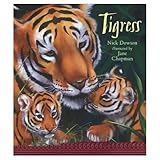
Price: £10.99
Publisher: Walker Books Ltd
Genre: Non Fiction
Age Range: 5-8 Infant/Junior
Length: 32pp
Buy the Book
Tigress
Illustrator: Jane ChapmanWhy do tigers have ear spots? They may help small cubs to follow their mother or perhaps they are flashed as a warning to other tigers but ‘no one knows for sure’. The speculative approach here, the sharing of theories, is likely to encourage young children to think and talk. There are two kinds of print – large and bold for the main story which follows a female tiger and her cubs through days and weeks – and italic which provides related information and introduces vocabulary like ‘camouflage’, ‘territory’ and ‘predators’. The use of the continuous present, so favoured by information story writers, works well here. For example, we have the drama and immediacy of a powerful verbal image: ‘Like fire the roaring tigress leaps and falls in a crush of teeth and muscle…’ matched by a visual image which gives a tremendous sense of movement and energy as the tigress and her cubs are shown hurtling across the pages towards their prey.
The author and illustrator give just the right amount of detail to interest the very young – tigers love swimming, they have a superb sense of sight and hearing but a less keen sense of smell than some other animals and they catch their prey in three out of every ten attempts. This information is not miscellaneous but carefully chosen to give a sense of the kind of creature the tiger is and what its daily existence is like. Female tigers are lone parents and she gives food first to her cubs remaining hungry herself if meat is short. Children are bound to comment on this and can be helped to understand that her apparent ‘unselfishness’ is a strategy for helping the species survive.
In the short author biography we read that tigers roam in the author’s dreams and he finds that they are ‘completely captivating and remain mysterious’. This strong interest and knowledge is extremely well communicated to young readers.



